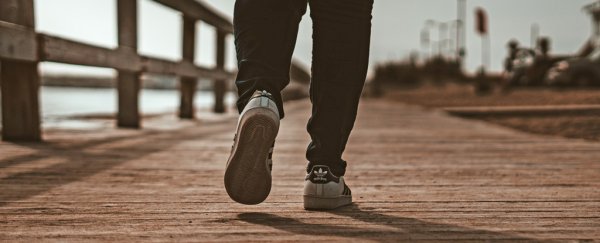Scientists have reported a possible link between brisk walking and biological age, as measured by leucocyte telomere length (LTL) – one of the biomarkers that scientists think we can use to assess the rate at which the human body gets older.
This 'biological age' essentially means how worn out the body's cells are getting. A lifetime of walking at speeds above an amble could mean the equivalent of being 16 years younger – cellularly speaking – by middle age using the metric.
Walking requires no training and no special equipment, and the researchers suggest it could be used more often in treatments as a way of improving health where appropriate.
"Whilst we have previously shown that walking pace is a very strong predictor of health status, we have not been able to confirm that adopting a brisk walking pace actually causes better health," says Tom Yates, a kinesiologist at the University of Leicester in the UK.
"In this study, we used information contained in people's genetic profile to show that a faster walking pace is indeed likely to lead to a younger biological age as measured by telomeres."
The researchers tapped into the UK Biobank database and pulled records on 405,981 middle-aged individuals. The genetic analysis they carried out suggested a causal link between brisk walking and LTL, independent of any other physical activity.
Movement intensity on walks was measured by self-reporting and also fitness tracking wearables worn by the people involved in the study. That intensity is important: A leisurely stroll doesn't appear to have the same effect (although any kind of movement is good for you).
Walking speed itself is influenced by a whole host of factors as well, everything from lung capacity and motor control to mental health and motivation levels. It's something doctors could look at as an indicator of overall health.
"This suggests measures such as a habitually slower walking speed are a simple way of identifying people at greater risk of chronic disease or unhealthy aging, and that activity intensity may play an important role in optimizing interventions," says medical research scientist Paddy Dempsey from the University of Leicester and the study's lead author.
"For example, in addition to increasing overall walking, those who are able could aim to increase the number of steps completed in a given time, e.g., by walking faster to the bus stop. However, this requires further investigation."
Telomeres cap off chromosomes in the human body, containing repetitive sequences of non-coding DNA that protect the chromosomes from damage – it's a bit like the way the caps at the end of shoelaces stop the shoelaces from unraveling.
These biomarkers naturally shrink as they get older, but research has shown that they can also be shortened more speedily by a lack of sufficient sleep, by demanding jobs, and by the stresses and strains of childbirth.
Brisk walking has previously been linked to an increase in life span of up to 20 years, and this longer life expectancy can result from as little as 10 minutes of walking a day. Now, we also have a causal link between this specific physical activity and telomere length.
"Previous research on associations between walking pace, physical activity, and telomere length has been limited by inconsistent findings and a lack of high-quality data," says Dempsey.
The research has been published in Communications Biology.
